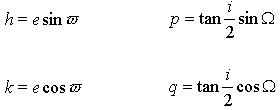Equinoctial Coordinate Type
The Equinoctial coordinate type uses the center of the Earth as the origin and the plane of the satellite's orbit as the reference plane.
The equinoctial coordinate type is not available if a Fixed coordinate system is selected.
The advantage of this element set is that singularities are limited to retrograde equatorial orbits, parabolic/hyperbolic orbits and collision orbits. The Keplerian element  (right ascension of ascending node) is undefined when the inclination is 0 and is numerically unstable for an inclination near 0. As the inclination approaches zero, the line of nodes becomes indeterminate. The Keplerian element
(right ascension of ascending node) is undefined when the inclination is 0 and is numerically unstable for an inclination near 0. As the inclination approaches zero, the line of nodes becomes indeterminate. The Keplerian element  (argument of perigee) becomes singular when the eccentricity is zero. As eccentricity approaches zero, the line of apsides becomes indeterminate. The Air Force Satellite Control Network (AFSCN) typically solves for the equinoctial elements during the orbit estimation process.
(argument of perigee) becomes singular when the eccentricity is zero. As eccentricity approaches zero, the line of apsides becomes indeterminate. The Air Force Satellite Control Network (AFSCN) typically solves for the equinoctial elements during the orbit estimation process.
Equinoctial coordinate type elements

 ,
,